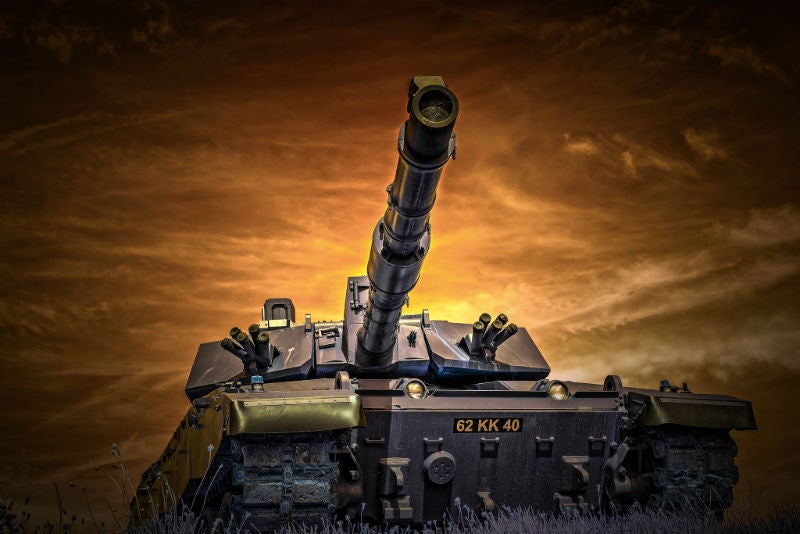
The UK Ministry of Defence (MoD) has been found to have used chromium-based military paint to corrosion-proof military vehicles as recently as December 2018, according to The Times.
This is despite the European Union having imposed a ban on the use of hexavalent chromium compounds since classifying them as hazardous and linking them to cancers in 2003.
Under the EU Registration, Evaluation, Authorisation and Restriction of Chemicals (REACH) regulation, which was ratified in 2006, the European Commission set a deadline for the use of chromates in paint to end in January 2019.
An MoD spokesperson told Army Technology: “Hexavalent chromium paint is no longer applied to any of our armoured vehicles and all existing vehicles will be repainted with chromate-free paint.”
Hexavalent chromium a ‘health risk’
Hexavalent chromium paint provides materials with added corrosion resistance and durability.
The British Coatings Federation (BCF) told Army Technology: “Chromates are still used in the coatings industry, but only for a very restricted number of uses, for example for aerospace applications, where the highest level of corrosion protection is required, due to the extreme conditions faced.
“They provide excellent anti-corrosive properties that could not be achieved by other alternatives, and where used, controls are in place to ensure safe use, to prevent exposure. It should also be noted that there is no exposure risk once the paint has been applied.”
However, it is considered a health risk according to the US National Cancer Institute and has been linked to lung cancer and cancer of the paranasal sinuses and nasal cavity.
Gaggan Mawi, an associate with the military claims team at UK law firm Bolt Burdon Kemp, told Army Technology: “The health risks posed by chromium VI are well documented, with the regulation of chromate paints having been in place for decades. There has also been litigation both in the US and Netherlands resulting in US troops and Dutch military personnel being compensated for illness caused by exposure to chromium paint.
“Yesterday’s statement by Defence Minister Stuart Andrew that the Ministry of Defence has been using chromium VI up until the end of December 2018 raises many questions when considering whether the MoD may find itself faced with similar litigation in the UK.”
MoD narrowly met deadline
The MoD’s use of chromium paint finished just before the January 2019 deadline, but the risks were identified years beforehand and safer alternatives were well known.
“For military vehicles, our members have been offering chromate-free paints for many years, which are perfectly suitable for this application. Most of the industry and the MoD shifted to chromate free products many years ago. However, the MoD maintained one specification which still required chromates for corrosion protection of specific types of aluminium equipment in a minority of applications,” the BCF said.
“Since January 2019, the manufacture and use of such products (chromates on military vehicles) has been ceased under the EU REACH regulation. Both the MoD and the coatings industry have fully complied with this regulation. BCF members consider the health and safety of its workers and users to be of highest concern, and follow the relevant regulations to make sure this high standard of worker protection is maintained.”
Could the MoD still face legal action?
The MoD has not broken the law and up until now there have been no reported illnesses in the UK defence sector from exposure to chromium military paint. But should it have acted sooner, and could it still face litigation?
“First, we need to understand how the decision to use these chemicals was risk assessed, and what alternatives were reasonably available for use,” said Mawi.
“It is currently unknown how many service people have been exposed to chromate paints over the years, the levels and length of exposure, and whether such individuals were provided with appropriate protective equipment, and training on how to handle the substances. More importantly, were personnel exposed to the substances advised of the risks posed to their health, and has there been any health surveillance in place to monitor any ill effects of exposure upon staff, and what effects have been reported?”
Ultimately, Mawi said, it is the duty of the MoD to take reasonable steps to ensure its workers are safe.
“In the event that it transpires that use of the chromate paints could and should have been avoided by the MoD, or that adequate and reasonable steps were not taken to protect those service personnel required to work with them, it may well find that it is faced with negligence claims for its failures to protect the health and wellbeing of its personnel,” Mawi concluded.



